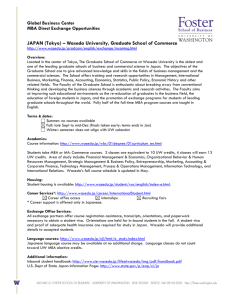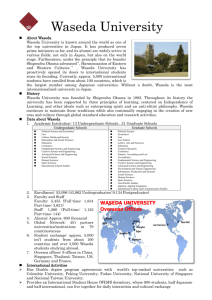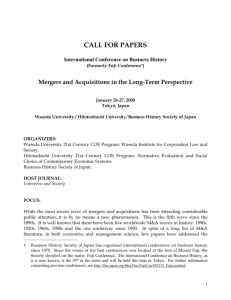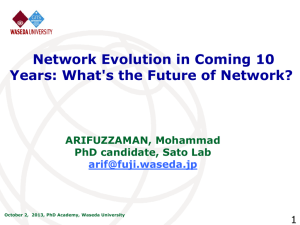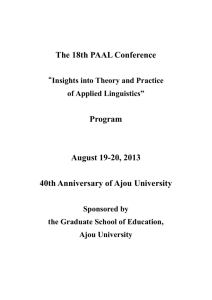Paper - Syracuse University
advertisement
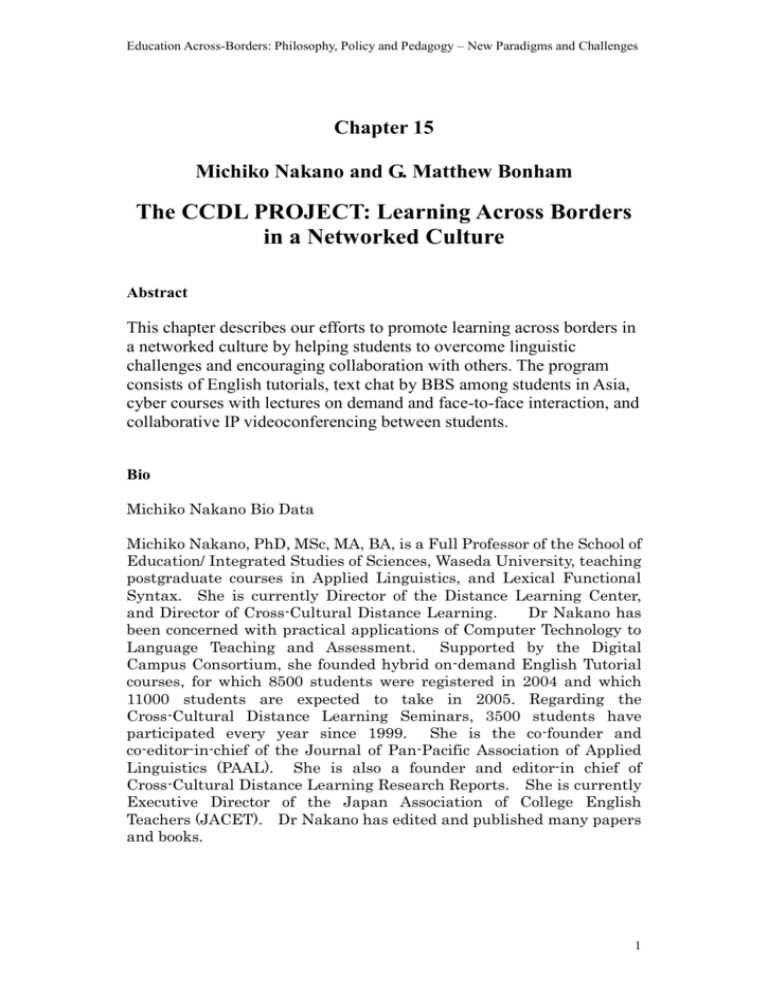
Education Across-Borders: Philosophy, Policy and Pedagogy – New Paradigms and Challenges Chapter 15 Michiko Nakano and G. Matthew Bonham The CCDL PROJECT: Learning Across Borders in a Networked Culture Abstract This chapter describes our efforts to promote learning across borders in a networked culture by helping students to overcome linguistic challenges and encouraging collaboration with others. The program consists of English tutorials, text chat by BBS among students in Asia, cyber courses with lectures on demand and face-to-face interaction, and collaborative IP videoconferencing between students. Bio Michiko Nakano Bio Data Michiko Nakano, PhD, MSc, MA, BA, is a Full Professor of the School of Education/ Integrated Studies of Sciences, Waseda University, teaching postgraduate courses in Applied Linguistics, and Lexical Functional Syntax. She is currently Director of the Distance Learning Center, and Director of Cross-Cultural Distance Learning. Dr Nakano has been concerned with practical applications of Computer Technology to Language Teaching and Assessment. Supported by the Digital Campus Consortium, she founded hybrid on-demand English Tutorial courses, for which 8500 students were registered in 2004 and which 11000 students are expected to take in 2005. Regarding the Cross-Cultural Distance Learning Seminars, 3500 students have participated every year since 1999. She is the co-founder and co-editor-in-chief of the Journal of Pan-Pacific Association of Applied Linguistics (PAAL). She is also a founder and editor-in chief of Cross-Cultural Distance Learning Research Reports. She is currently Executive Director of the Japan Association of College English Teachers (JACET). Dr Nakano has edited and published many papers and books. 1 Nakano & Bonham – The CCDL Project: Learning Across Borders in a Networked Culture G. Matthew Bonham is Professor of Political Science and Chair of the International Relations Program at the Maxwell School of Syracuse University. His field of study is international political communications. His recent publications include "Learning Through Digital Technology: Text Chat, Video-Conferencing, and Hypertext" in Active Learning in International Studies for the 21st Century [2000]; "The Disruptive and Transformative Potential of Hypertext in the Classroom: Implications for Active Learning", International Studies Perspectives [2000]; and "Attributions of Corruption in Azerbaijan and Iran" in Oil in the Gulf: Obstacles to Market Economy and Democratic Development [2004]. 2 Education Across-Borders: Philosophy, Policy and Pedagogy – New Paradigms and Challenges Michiko Nakano and G. Matthew Bonham The CCDL PROJECT: Learning Across Borders in a Networked Culture Introduction Globalization, enhanced by rapid technological innovations, is transforming education into a microcosm of a new interdependent world. This interdependence has made language and communication the single most important commodity of the future. It is mainly through the medium of language that effective communication across borders can take place. Learning in a Networked Culture The commitment of prominent universities and professional schools to the development of digital course material for the Web has stimulated debate about its efficacy for promoting learning. Some argue that the unique properties of the Internet (connectivity, non-linearity, de-centering, and virtual presence) offer opportunities for learning across borders that a standard classroom could never match. For example, Taylor (2001, p. 234) predicts that these technological innovations will have a profound effect on the curriculum: ‘In the future the curriculum will look more like a constantly morphing hypertext than a fixed linear sequence of prepackaged courses. When knowledge changes and both seminar tables and lecture halls become global, traditional classrooms will not remain the same’. Inevitably, the traditional classroom has changed. ‘Most important, the classroom has expanded and now is global. Anyone, anywhere in the world can, in principle, sit down around the same virtual table and learn together’ (Taylor, 2001, p. 234). Nevertheless, Taylor also warns that universities, as they are now configured, are not well positioned to take advantage of ‘networked culture’. What makes this situation particularly troubling is that educational institutions are ill-equipped to cope with these developments, and many educators are not inclined to seek creative responses. The organizational structure and governance procedures of colleges and universities make it almost impossible for them to operate effectively in a world moving at warp speed. To prosper in network culture, it is necessary to make decision expeditiously and to develop programs quickly and efficiently (Taylor, 2001, p. 234). Sections of this paper were presented at the ED-Media 2003 World Conference on Educational Multimedia, Hypermedia, and Telecommunications (Bonham, G.M., Surin, A., Nakano, M., & Seifert, J.W., 2003). 3 Nakano & Bonham – The CCDL Project: Learning Across Borders in a Networked Culture In this chapter, we will discuss our attempts to collaborate to promote learning across borders in a networked culture, including the linguistic, cultural, and technological challenges that we have encountered. We will begin, however, by describing our pedagogical objectives in this effort: incidental and contextual learning; independent and active learning; and collaborative learning. Pedagogical Objectives We agree with Taylor (2001, p. 234) that technological innovation has altered and will continue to transform ‘what educators do as well as how they do it’. Both educators and students can share excitement about technological innovation in higher education, implementing changes that will have a transformative effect on classroom learning. While technology offers a range of opportunities that a standard chalk–and-talk class could never match, questions about the educational value of the new digital media seem to loom large among the educators who still insist on a standard ‘chalk and talk’ lesson. To the students who believe in the new method of teaching, the visual images, sounds, animations, and streaming videos really add to the learning experience, but to those educators who retain the method of chalk and lecture in the classroom, digital technology may merely seem to provide an entertaining distraction. If so, how can technology be used more effectively to promote student-centered learning? Incidental and Contextual Learning Our first objective involves abandoning the conceptual system based on the idea of linear sequencing of teaching (Landow, 1992, p. 2) in order to facilitate implicit, incidental, and contextual learning (Snyder, 1996, p. 103). As learners move through a text, they should not be locked into the perspective of the author, but rather should be guided by their own interests, jumping back and forth, omitting material, skimming detail, or going deeper than the author intended. By departing from the author's organizing framework and following a non-linear strategy, learners are able to integrate better course materials and information into their own conceptual frameworks. Words and images can be inter-linked, creating multiple paths that encourage the integration of information (Seifert and Bonham, 1997). Not only does this approach facilitate understanding, but it also helps students to learn how to work in a world that is neither linear nor disciplinary. Independent and Active Learning Our second objective is to promote independent and active learning by students. Both traditional lecture courses and many courses that utilize computer technology treat students like passive objects whose purpose is to absorb “knowledge." Instead, we would like to transfer ‘to students much of the responsibility for accessing, sequencing, and deriving meaning from information’ (Snyder, 1996, p. 103). Having accepted this responsibility, students will move from being spectators to real involvement with their teachers, classmates, and others who share their interests. In other words, we hope to use digital technology to empower students to pursue their interests. 4 Education Across-Borders: Philosophy, Policy and Pedagogy – New Paradigms and Challenges Collaborative Learning Our third objective is to encourage collaboration with others, including learners in distant locations across borders. Learners should be able to work with each other successfully not because of geographical propinquity (for example, they are sitting next to each other), but because they share an interest in a particular subject matter. In other words, students will be able to work together in virtual space based on interest rather than spatial site (Landow, 1992, p. 129). ‘The result is a much more de-centered, multiperspectival universe of imagined communities’ (Deibert, 1997, p. 198). In this chapter we will describe some of our efforts to promote education across borders by using resources that exploit the de-centering properties and the virtual presence of the Internet. Specifically, we explore the effectiveness of combining Web-based text chat with interactive digital videoconferencing to create a new learning environment, where students in Asia, the United States, and Russia collaborate with their colleagues abroad to address current issues. Our efforts can be viewed as a component of ‘knowledge media,’ a term first used by Stefik (1986) to describe ‘the profound impact of coupling artificial intelligence technology with the Internet’ (Eisenstadt and Vincent, 1998, p. 4), and later elaborated by Eisenstadt and Vincent (1998, p. 4) to include ‘the process of generating, understanding and sharing knowledge using several different media, as well as understanding how the use of different media shape these processes’. According to Eisenstadt and Vincent (1998, p. 4), ‘One of the most exhilarating and rewarding aspects of the Internet is the way it brings people together. Being able to share and reuse knowledge is a fundamental aspect of the new possibilities made available through creative uses of Knowledge Media’. Overcoming Linguistic Challenges: The Cross-Cultural Distance Learning (CCDL) Project With a view toward overcoming linguistic challenges and to meeting the future needs of its students, Waseda University initiated the Cross-Cultural Distance Learning (CCDL) Project. This project began in 1998, and currently has thirtyeight participating universities, mainly from twelve countries: the Philippines, Malaysia, Korea, England, Scotland, Singapore, Thailand, Brunei, Russia, USA, Taiwan, and China (Peking and Hong Kong). It has three main objectives for the undergraduate level of education: to develop mutual understanding of different cultures, to enrich the foreign language learning experiences and to encourage equitable access to advanced information technology through co-operation and sharing of resources. The project is also concerned with the graduate level of education; it aims at enhancing teacher/facilitator skills through a series of cyber lectures and virtual workshops, where leaders in the field share their views on language teaching or applied linguistics with all participating members of the project. The project, thus, caters for the needs of both facilitators and students. Initial Efforts: CCDL Activities at Waseda University In 1999, Waseda University founded a consortium of 27 corporations, called the 5 Nakano & Bonham – The CCDL Project: Learning Across Borders in a Networked Culture Digital Campus Consortium (DCC). DCC gave us financial support to develop CCDL activities particularly in the Asia-Pacific region. In 1999, we visited major universities in Asia to propose joint experimental courses using chat systems or video-conferencing systems. We discovered that in Asian universities many computers were available in the Science Faculty, but almost none in the Faculty of Arts. For this reason, we donated three personal computers and later one video-conferencing system to the participating universities. This donation enabled us to start a large-scale collaboration from the beginning. DCC aimed to realize a new model of university education for the 21st Century. Our mission was to educate Global Citizens who are active international intellectuals and who can solve real problems in the world. For this purpose, we established a three-staged educational system: the first stage is to improve the proficiency levels of the target languages (English, Chinese, Russian, and Japanese), the second, to enable the students to interact with overseas partners and to discuss controversial issues and the third, to interact with overseas specialists in the field. For the purpose of the first stage, we established Language Tutorial Systems, in which a group of four students are taught by one tutor. Such language programs were essential for the students at Waseda, since their proficiency in spoken English was not up to the international standards; average TOEIC score was 550. We will describe some typical language tutorials in the next section. English Tutorials The purpose of the English tutorial is to improve students’ English speaking abilities in order to conduct daily and business transactions. We prepared two courses: General and Business English, each with three levels Beginner, Intermediate and Advanced. Tutorial lessons were held twice a week, totaling 24 hours. In addition to the tutorial speaking exercises, the program had the following features: Original textbooks Web-based materials for essay writing Students write three types of essays in a term. Teachers give feedback on-line. Teacher-student, student-student discussion on BBS Students are required to watch several on-demand videos about essay writing per unit. Students write an essay in the MS Word format and post it to the BBS. Teachers correct the essay and return it onto the BBS. Students correct the errors and submit the revised essay again. Students can ask questions on the BBS or by e-mail. Registered students are required to take the TOEIC-IP test for class-level placement before the start of the Program. They can also take the TOEIC-IP test again at the end of the Program if they wish. 6 Education Across-Borders: Philosophy, Policy and Pedagogy – New Paradigms and Challenges 3 Steps for Promoting Language Ability Practice 3rd Step “Cyber Lectures ” 2nd Step CCDL - Cross-Cultural Distance Learning Sem inars 1st Step “Tutorial language Learning Program ” Training Time In the 24-hour training, the students managed to raise their scores 59 points on average. Due to these Tutorial programs, our students became able to have meaningful sessions with overseas partners in the second stage, called Cross-Cultural Distance Learning seminars (CCDL in short).The CCDL seminars with overseas partners gave our students authentic communication activities. In the next section, we will describe CCDL activities in the classroom. Fig 1.The average scores in April and July (n=277) 700 600 500 579 520 400 300 262 258 Listening Reading Total 298 281 200 100 7 0 Nakano & Bonham – The CCDL Project: Learning Across Borders in a Networked Culture Students improved their total scores by 59 points on average. With an alpha level of .05, this gain score was statistically significant, t (276) = 15.35, P < .001. Total No. Min. Max. Ave. SD April 277 250 935 520.29 116.15 July 277 260 925 579.48 117.95 Listening No. Min. Max. Ave. SD April 277 105 495 262.24 67.25 July 277 95 495 298.05 68.72 Reading No. Min. Max. Ave. SD April 277 100 440 258.05 64.74 July 277 90 430 281.43 61.40 t-value d .f. P 15.35 276 P<0.001 t-value d .f. P 12.89 276 P<0.001 t-value d .f. P 9.64 276 P<0.001 CCDL Activities in the Classroom First, the students are encouraged to practice typing till they can type 30 words per minute. Then, they register their profile on our home page with their photographs, and send e-mails to their partners to make chatting or video-conferencing appointments. They are encouraged to chat by BBS once or twice a week. The 200-word summary of their BBS information exchanges is reported on our home page, as well. When a group of students who share the same interest feel like a face-to-face dialog by videoconferencing, they are encouraged to do so. At the end of the term, each student submits his/her final report and gives a public presentation, using MS PowerPoint. With respect to BBS chatting, we identified three pedagogical stages: Stage 1: To obtain information on a partner’s country from a partner, for example, cultural quizzes, self-introduction, daily life, sports, etc. Stage 2: To learn about a partner’s country and explain one’s own culture, attaining mutual understanding, breaking down stereotypes, etc. Stage 3: To express one’s opinion on current topics, such as environmental problems, world affairs, and so on. The following three excerpts illustrate a BBS chat at Stages 1 to 3. 8 Education Across-Borders: Philosophy, Policy and Pedagogy – New Paradigms and Challenges Stage 1: Which religion is most popular in Korea, Buddhism, Confucianism, Christianity or a cult? Waseda Edu#2: What is the most popular religion in Korea? Korea-E#4: do you think confucianism is religion? Waseda Edu#2: Our teachers said so Korea-E#4: But in fact it's not religion exactly Waseda Edu#2: How's that? Korea-E#4: it's a basic principle of living Korea-E#4: mabye buddism? Korea-E#4: it's so general Korea-E#4: and catholic Korea-E#4: do you have a religion? Waseda Edu#2: I'm buddist^^ Stage 2: Interaction with a Philippine student about American Dream DeLaSalle PC2: ***, Do you know the movie or play AMERICAN DREAM? Waseda Edu. #1: oh I was surprised that about visa Waseda Edu. #2: what do they want to do, in the us? DeLaSalle PC2: They believe that work is better and the pay is better in the US. DeLaSalle PC2: some people go there and never comes back DeLaSalle PC1: who does? i also do not agree woth the american system, but the people there generally nice Waseda Edu. #2: they think they can succced? DeLaSalle PC2: Well, I know of some who succeeded... better education for their children and got better jobs Stage 3: Interaction with a Philippine student about Economic Discrepancy Waseda Edu#7: I want to know how the difference between rich and poor affect the life in your country. That is difficult topic? DLS-E #1: not at all.. DLS-E #1: the differences between the rich and poor are very obvious here.. DLS-E #1: (such a serious topic!) DLS-E #1: only about 20% of the population control the wealth... DLS-E #1: and the resources are not evenly distributed Waseda Edu#7: 20%? That sounds very low. DLS-E #1: imagine a triangle divided into 3 horizontally.. Waseda Edu#7: All of the poor can't go to school? (continued) DLS-E #1: the big bottom base is that of the poor DLS-E #1: its always a problem every year about schooling DLS-E #1: the start of the school year, the students had schools but they didnt have tables and chairs... DLS-E #1: so they had to study on the floor! DLS-E #1: but the Department of education is working hard to remedy that... 9 Nakano & Bonham – The CCDL Project: Learning Across Borders in a Networked Culture DLS-E #1: there are public schools for free but most of them would rather work than study... DLS-E #1: may i ask why you are interested about this topic? Waseda Edu#7: In Japan, there is no difference between rich and poor. DLS-E #1: none at all??? Waseda Edu#7: I seldom feel it. DLS-E #1: there are a lot of people here who dont have land to live in so they stay in other people`s land... they are called squatters. The following five points characterize the CCDL activities from the viewpoint of English Language Teaching (ELT): 1. Students can actively engage in actual cross-cultural communication through learner-learner interaction. 2. Students who are not confident can feel more at ease with non-native speakers than with native speakers. 3. Students can broach, change, and expand a topic relatively easily as their discussion unfolds. 4. Students who are shy?? are more expressive in computer-mediated communication than during face-to-face interaction. 5. Students can self-monitor or focus on linguistic forms more than in face-to-face communication. Overcoming Cultural Challenges: Omnibus On-Demand Cyber Courses with Face-to-Face Interactions To help students to overcome cultural differences in communication, CCDL sought to educate students as ‘global citizens’. Our first definition was: Active and intellectual individuals who can cope with real problems in the world. They should be young leaders in the Asian community. They should know our common heritage in the Asian community. They should have the sense of belonging to the Asian community, so that they should know how to be co-operative in the community. To expand the sense of belonging to the Asian community. To do so, the sense of human relatedness should be based on one’s family, university, country…to the Asian community, to the world. We decided to start with daily issues in Singapore or in Hawaii, where the sense of multi-cultural society is well developed. We decided to deal with cultural differences seen thorough our daily life and particularly in communicative activities. But, the final goal is for students to be able to form their opinions on current issues, based on their knowledge of their university major. In order to achieve these educational objectives, we developed three-staged educational program in which communication abilities are the fundamental components. As Nakano (2003) indicates, CCDL activities which emphasized BBS chatting 10 Education Across-Borders: Philosophy, Policy and Pedagogy – New Paradigms and Challenges (although we provided occasional video-conferencing) had some shortcomings in that the students use very short simple sentences during the BBS chatting sessions - the mean lengths of utterance [MLU] were 6.05 among Waseda University students, 5.08 among Korea University students and 8.29 among De La Salle University students, respectively. This can be compared with the MLUs for e-mail and essay-writing in Table 1. Table 1 Subject/Learner French 1st year univ. students of English French 3rd and 4th year university students Dutch 3rd and 4th year university students Native Speakers of American English Native Speakers of British English Waseda University Students (e-mail) Waseda University Students (CMC) Mean Length of Utterance (MLU) 17.25 19.08 17.59 18.26 22.36 15.08 6.05 (Data from Nakano, et al., 1999) This suggests CMC should be regarded as a conversational rather than a written form of exchange. In fact, Nakano (2000, 2003) showed that BBS chatting can be characterized as conversational writing - satisfying some aspects of interactive everyday dialog in terms of vocabulary level, sentence length, turn-taking (overlapping and butting-in), conversational features in lexical use and delivery speed (if the students’ typing speed matches their speaking speed, particularly at the intermediate level). For this reason, students are encouraged to make digital videos to introduce Japanese culture and Japan’s social system to their Asian friends in English. The following is a partial list of video topics: Asakusa Temple: Today’s Special News from New York Eco Campus: Waste Disposal Problems @ Waseda Rush Hour Vending Machine 和 - Sense of Harmony in Japanese Society Pak’s Visit to Tokyo Sense of Money Separation of Smoking Areas Promoting human relationships Ramen culture around Waseda Interviews with exchange students at Waseda In this section, the third stage of our educational program is introduced and described. There are about 100 on-demand courses at Waseda University. Only the most recent courses are used, which include multi-point video conferencing as components. 11 Nakano & Bonham – The CCDL Project: Learning Across Borders in a Networked Culture Co-existence in Asia Our first multi-point omnibus-style instruction consisted of eight on-demand lectures and two live sessions. Each faculty member from the participating universities provided two on-demand lectures. Basically, the lectures were related to the primary theme of Co-existence in Asia. The course, including teaching materials, lectures and BBS Q&A, was conducted in English. Either a symposium or a workshop was held at the end of the semester course, when the students got together to give presentations on their work. We repeated the same joint online experiment twice in 2003, as follows. Experimental Phase 1 (2003. 4 ~ 7) - Course Period: April 17th – July 1st, 2003 Participating Universities: Korea University (17), National University of Singapore (13 participants), Thammasat University (12) and Waseda University (21) Sept.17 ~ Oct. 7: Prof. Bhanupong Nidhprabha, Thammasat University 1) “Thailand’s Foreign Trade Reform” 2) “From Multilateral Agreement to Bilateral Negotiations” >> Quiz (Sept.24 to Oct.7) Oct. 8 ~ Oct. 21: Prof. Mannsoo Shin, Korea University 3) “Recent Trends in Global Business Environment I” 4) “Recent Trends in Global Business Environment II” >> Quiz (Oct.15 to Oct.21) Oct.22 ~ Nov. 4: Prof. Takashi Terada, National University of Singapore 5) “Japan-Singapore Economic Partnership Agreement (JSEPA): Asia’s first bilateral FTA” 6) “The Rise of East Asian Regionalism and Japan” >> Quiz(Oct.24 to Nov.4) Nov. 5 ~ Nov.18: Prof. Toshihiko Kinoshita, Waseda University 7) “How to avoid repetition of currency crisis in East Asia? <1>” 8) “How to avoid repetition of currency crisis in East Asia? <2>” >> Quiz (Nov.12 to Nov.18) Experimental Phase 2 (2003. 9 ~ 11)-Course Period: September 17th – November 26th, 2003 Participating Universities: Korea University (17 participants), National University of Singapore (10), Thammasat University (11) and Waseda University (23). The same on-demand course was repeated again. The experimental on-line joint course was a non-credit course. For this reason, some students dropped out. However, many students appreciated the value of this course: ‘I like this course style, which I can attend the lectures anywhere at any time if Internet environment is available.’ ‘I really liked this course as I could attend anywhere at any time I 12 Education Across-Borders: Philosophy, Policy and Pedagogy – New Paradigms and Challenges wanted. It was a good lesson for me to study and discuss with other participating students from overseas universities. Now I’d like to learn about Asian studies with this course as a turning point.’ ‘When I first started taking this course, I never realized how we are trying to do new things, and how novel this course was going to be. But it was really exciting to listen to the lectures from four different professors from four different countries.’ ‘I was very glad to join this program, especially the students' BBS. I enjoy sharing opinions on various topics with students of other countries. I hope that I may have a chance to participate in programs like this in the future.’ We distributed a questionnaire among the participants. The response rates were 17 out of 34 participants at Korea University, 6 of 23 at National University of Singapore, 4 of 23 at Thammasat University, and 28 out of 45 participants at Waseda University. The details are outlined below in Table 2. World Englishes and Miscommunication There are at least two views of English as a global and English as an International Language (EIL). Most people agree that English today has achieved the status of a lingua franca, not because of the growth in the number of native speakers but because of the increase in the number of individuals in the world who have acquired English as an additional language. Although the initial spread of English was due to native speaker migration, resulting in the development of largely monolingual English-speaking communities (e.g. the USA and Australiasia), the current spread of English is due to individuals acquiring English as an additional language for international and, in some contexts, intra-national communication. This results not in monolingualism, but rather large-scale bilingualism. Some reasons for this trend of English as a global lingua franca include: 1. Many learners of English today have specific purposes in learning English, which in general are more limited than those of immigrants to English-speaking countries, who may eventually use English as their sole or dominant language. Table 2 13 Nakano & Bonham – The CCDL Project: Learning Across Borders in a Networked Culture 5% Q1. What do you think about those features of the joint experimental course “Coexistence in Asia”? 1) You can view the lecture contents as often as you wish during the reference period. 2) 2) BBS enables us to exchange opinions any time and anywhere. 0% 2% 18% 44% very useful useful neutral not useful not useful at all no answer 31% Q3. What do you think of the course style (Omnibus instruction)? 5% 2% 2% 16% 46% 29% very convenient convenient neutral inconvenient very inconvenient no answer 4% 2% 36% I like the omnibus style acceptable I prefer to the regular style no answer 58% Q2. Are you satisfied with sharing the course with other participating students at overseas universities? Q5. Do you want to join this sort of collaborative video conferencing again? 2% 0% 4% 29% 5% 60% definitely satisfied generally satisfied neutral not satisfied not satisfied at all no answer Yes no idea No 7% 13% 80% Q4. Are you satisfied with the lecture contents? 0% 11% 9% 24% 56% 14 definitely satisfied generally satisfied neutral not satisfied not satisfied at all Education Across-Borders: Philosophy, Policy and Pedagogy – New Paradigms and Challenges 2. Many speakers of English as an additional language (L2) will be using English to interact with other L2 speakers rather than with ‘native speakers’. 3. Many current learners of English may desire to learn English in order to share with others information about their own countries for such purposes as encouraging economic investment, promoting tourism, etc. On the other hand, English as an International Language (EIL) tends to emphasize three points: 1. Learners of EIL do not need to internalize the cultural norms of ‘native speakers’ of English 2. The ownership of EIL has become de-nationalized 3. The educational goal of EIL is often (and should be) to enable learners to communicate their ideas and cultures to others. English is being studied and used more and more as an international language in which learners acquire English as an additional language of wider communication. The dominance of ‘native-speakers’ and their culture has been seriously challenged. It is time to recognize the multilingual context of English use and put aside a native-speaker model of curriculum development. Only then can an appropriate EIL curriculum be developed in which local educators take ownership of English and the manner in which it is taught. For this shift in the nature of English, we prepared an omnibus on-demand course with occasional multi-point videoconferencing called ‘World Englishes and Miscommunications’. In this course, we focus on specific syntactic, lexical, phonological, pragmatic, para-linguistic features of each variety of English that might cause misunderstanding. The varieties we dealt with are Chinese English, Korean English, Malay English, Singapore English, Philippine English, Indian English, Taiwan English and Japanese English. Overcoming Technological Challenges: Collaborative IP Videoconferencing between Japan, Russia, and the USA In this section, we describe a further extension of our efforts to promote learning across borders, using resources that capture the de-centering properties and the virtual presence of digital technology. Specifically, we explore the effectiveness of combining interactive digital videoconferencing with a Web-based discussion forum to create a new learning environment, where students in Japan, Russia, and the United States collaborate with their colleagues abroad to discuss solutions to current policy issues. We call this new environment, ‘collaborative videoconferencing’. The first IP (H.323) videoconference in the series was organized by students at the School of Education at Waseda University and the Maxwell School of Syracuse University on the topic of multiculturalism. In this conference, Waseda graduate students interacted with Maxwell graduate students for one hour on 27 March 2001. The two groups had no prior contact before the conference, and they did not follow up with e-mail exchange or other interaction. The students on both 15 Nakano & Bonham – The CCDL Project: Learning Across Borders in a Networked Culture sides were strongly positive about the videoconference, but no attempt was made to measure systematically how much they had learned about the topic, or their level of involvement in the conference. In November 2002, students in Russia and the United States participated in an IP-videoconference on the topic of ‘homeland security.’ The students in the US, who were enrolled in a professional Masters Degree program, participated as part of their regular course work. The group in Russia was much smaller, consisting of five students who were in their fourth or fifth year of study, and one doctoral student, who acted as the moderator. All of the participants on the Russian side were selected to participate in the conference. The conference began with self-introductions and short comments from three students on the American side, as well as from all of the participants on the Russian side. The interaction continued without interruption for one hour. After the conference, the participants completed a questionnaire that was designed to measure self-reports on what they learned and their interest in participating in future videoconferences. The students did not have the opportunity to exchange e-mail with each other or engage in asynchronous interaction through a discussion forum prior to the videoconference. In other words, the videoconference was a single, discrete activity with no prior preparation and no follow-up November 2002 Questionnaire Results Although the students who participated in the November 2002 videoconference reported that they gained only a modest amount of knowledge about the problem of homeland security in their own countries, they indicated that they did learn a substantial amount about the problem in the country on the opposite side. In addition, all of the Russian students were very enthusiastic about participating in ‘another videoconference like this one’, while only about 60% of the Maxwell group expressed considerable interest in participating in another conference. The March 2003 Homeland Security Videoconference In order to promote greater effectiveness of this new learning environment, another group of students Russia and the United States prepared first for a videoconference on homeland security in March 2003 by using an asynchronous on-line e-discussion1 forum to exchange ideas and develop a conceptual structure before the conference occurred. After the videoconference a questionnaire was administered to the participants to measure the ability of Internet-based ‘Knowledge Media’ to promote learning across borders. March 2003 Questionnaire Results For the purposes of this analysis, we will compare the Maxwell students who participated in the November 2002 videoconference with the Maxwell students who participated in the March 2003 videoconference. As expected, the March 1 (http://www.maxwell.syr.edu/ir/Discussion/homeland-security_frm.htm) 16 Education Across-Borders: Philosophy, Policy and Pedagogy – New Paradigms and Challenges group (discussion forum) reported that they learned more about the problem of homeland security in both the United States and the Russian Federation than did the November group (no discussion forum). This group also reported doing much more reading to prepare for the videoconference than did the group of students who participated in the earlier videoconference. The March group reported much more enthusiasm for participating in another videoconference (their average score on a five-point scale was 4.52 compared to only 3.76 for the November group). The differences were even larger for the collaboration measures, such as contacting the Russian participants (3.69 compared to 1.60), and collaborating with the Russians on a project (3.69 compared to 2.10). A further analysis of the correlations between the questionnaire variables reveals that for the March group, preparation for the videoconference by doing additional reading was not highly related to any other self-report. However, making a verbal contribution during the videoconference was related to self-reported learning about homeland security in Russia (Kendall’s tau b = .42), which, in turn was related to wanting to participate in another videoconference (Kendall’s tau b = .44). Conclusion During our first DCC International Conference at Waseda University in 2001, Mrs. Goh Chi-Lan, Director of the Regional Language Center, SEMEO, cited the following statement made by Senior Minister of Singapore, Lee Kuan Yew: ‘The lesson that I have learnt and which I’ve got to pass to you is that change is the very essence of life for us. Complacency has no place…in the new age: we have to change to advance with the times’. Every year, Waseda University accepts more than 10,000 students from overseas, who have been educated in constantly changing environments. We educators are obligated to change to advance with the times, especially as our world becomes smaller through internationalization and globalization processes. One of the most essential characteristics of successful implementation of educational multimedia in networked (across-borders) culture is the capacity for future development, both technologically and pedagogically. Over the past several years, the technology has evolved significantly, providing opportunities to test new methods of teaching and learning. Although many students who participate in videoconferences are distracted by technical problems and the lack of eye contact, especially those who are more involved in the discussion, technological improvements, such as high definition (HDTV) video over the Internet, promise to make the interaction seem more natural. When applying the new technology to our pedagogy, however, we should not focus too much on the technology, itself, which sometimes makes us lose sight of our students and their needs. Rather, we should be using the technology to re-construct the classroom, whether it is in cyberspace or in a classroom building, to capture the new opportunities that are available in across-border educational encounters. 17 Nakano & Bonham – The CCDL Project: Learning Across Borders in a Networked Culture Nevertheless, we must be realistic about the challenges that confront those who attempt to promote learning across borders. External financial support is often critical to the success of collaboration. For example, the CCDL Project was able to obtain funding to purchase computers for its partners in Asia, and the Maxwell School benefited from a the US Department of State grant that supplied videoconferencing equipment to its Russian partner. Other challenges are organizational in nature. Educators play a critical role in developing and nurturing contacts with colleagues abroad to provide their students with opportunities to engage in learning across borders. Once these relationships are established, educators often must motivate their students to interact in a second language, such as English, to take advantage of them. Educators also face the challenge of motivating their students to follow up BBS or videoconference discussions by working with their peers on individual or group projects. As a result of our research program on applications of digital technology, we now view the classroom as being created by the students, themselves, with technology as the resource to encourage active learning. To that end, our efforts to promote cross-cultural distance learning provide a qualitatively different experience, compared to other forms of learning. We have found, for example, that collaborative videoconferencing, which combines an asynchronous discussion forum with face-to-face interaction, results in more learning and greater enthusiasm for future collaboration, than does a traditional classroom setting. We believe that this approach has the potential to transform what we do in the classroom and how students, themselves, learn from each other and from other across-borders students, who may or may not be physically present. 18 Education Across-Borders: Philosophy, Policy and Pedagogy – New Paradigms and Challenges References Bonham, G. M., Surin, A., Nakano, M., & Seifert, J. W. (2003). IP Videoconferencing in Graduate Professional Education: Collaborative Learning in Japan, Russia, and the United States. In Proceedings of the ED-Media 2003: World Conference on Educational Multimedia, Hypermedia, & Telecommunications. Bonham, G. M. & Seifert, J.W. (2000). The disruptive and transformative potential of hypertext in the classroom: implications for active learning, International Studies Perspectives, 1, 57-74. Deibert, R. J. (1997). Parchment, Printing, and Hypermedia. Communication in World Order Transformation. New York: Columbia University Press. Eisenstadt, M. & Vincent, T. (1998). The Knowledge Web. Learning and Collaborating on the Web. London: Kogan Page Limited. Park, K., Nakano, M. & Lee, K. (2003). Cross-Cultural Distance Learning and Language Acquisition. Seoul: Hankook Publishing Co.Landow, G. P. (1992). Hypertext. The Convergence of Contemporary Critical Theory and Technology. Baltimore, MD and London, UK: The Johns Hopkins University Press.Nakano, M., Yamazaki, T., Miyasaka, N., & Saito, T. (1999). A Study of EFL Discourse Using Corpora (7): An Analysis of E-Mail Discourse and Variation of Expressions. In Proceedings of the 4th Conference of Pan-Pacific Association of Applied Linguistics. Nakano, M. (2003). Cross-Cultural Distance Learning. Lecture presented at JICA, FD Seminars for South East Asian Countries.Nakano, M. (Ed.) (2003). CCDL Research Reports, Vols. 1, 2 & 3. CCDL Research Center, Waseda UniversityNakano, M. (Ed.) (2003). CCDL Research Reports, Vol. 4. CCDL Research Center, Waseda University Seifert, J. W. & Bonham, G..M. (1997). Using the World Wide Web: Expanding the Classroom or a Virtual Distraction? Paper presented at the Annual Meeting of the American Political Association. Seifert, J. W. & Bonham G. M. (2000). Learning Through Digital Technology: Text Chat, Video-Conferencing, and Hypertext. In L. Kuzma, J. Lantis, & J. Boehrer, (Eds.), Active Learning in International Studies for the 21st Century. Boulder, CO: Lynne Reinner, 201-217. Snyder, I. (1996). Hypertext. The Electronic Labyrinth. Carlton South, Australia: Melbourne University Press. Stefik, M. (1986). The next knowledge medium, AI Magazine, 7, 34-46. Taylor, M. C. (2001). The Moment of Complexity. Emerging Network Culture. Chicago: University of Chicago Press. 19
